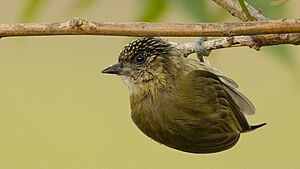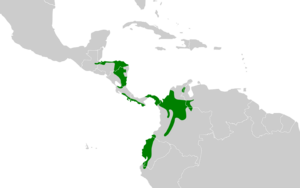Olivaceous piculet facts for kids
Quick facts for kids Olivaceous piculet |
|
|---|---|
 |
|
| Conservation status | |
| Scientific classification | |
| Genus: |
Picumnus
|
| Species: |
olivaceus
|
 |
|
The olivaceous piculet (Picumnus olivaceus) is a small, interesting bird that belongs to the woodpecker family. Even though it's related to woodpeckers, it's much smaller and has some unique habits. You can find this bird living in Central America, from Guatemala all the way south through countries like Costa Rica and Panama, and then into western South America, reaching Peru.
Contents
Understanding the Olivaceous Piculet's Family Tree
Birds are grouped into families and subfamilies based on how they are related. The olivaceous piculet is part of the Picidae family, which includes all woodpeckers. It's in a special group called Picumninae, which are the piculets.
Different Types of Olivaceous Piculets
Scientists have found six different types, or subspecies, of the olivaceous piculet. These subspecies are slightly different from each other, often in their colors or where they live. They are:
- P. o. dimotus
- P. o. flavotinctus
- P. o. olivaceus
- P. o. eisenmanni
- P. o. tachirensis
- P. o. harterti
The olivaceous piculet is very similar to another bird called the grayish piculet. For a while, people thought they were the same species! Now, they are considered separate but very close relatives.
What Does the Olivaceous Piculet Look Like?
This tiny bird is about 8.5 to 10 centimeters (3.3 to 3.9 inches) long. It weighs only 10 to 15 grams (0.35 to 0.53 ounces), which is about as much as a few paper clips!
Colors and Markings
Adult male olivaceous piculets have a black head with red tips on the feathers at the front and top. The rest of their head has white spots. Their face is mostly brown with white feather tips. Their back and upper parts are olive-brown with a hint of yellow. Their tail is brown, with some pale yellow or buff stripes on the outer feathers.
Their chin and throat are a light yellowish-white, often looking a bit scaly. Their chest is yellowish-brown, fading to a lighter yellowish-white on their belly. The belly and sides have brownish streaks. Their eyes are dark brown, and their beak is black with a gray bottom part. The skin around their eyes is gray to blue-gray, and their legs are gray with a green or blue tint.
Male vs. Female vs. Young Birds
Female olivaceous piculets look almost exactly like the males, but they have white spots all over their head and no red feathers. Young piculets are usually duller and browner than adult birds. They might also have lighter and more streaky underparts.
Subspecies Variations
The different subspecies have slight color differences:
- P. o. dimotus has more green on its back and is lighter below. Its head feathers have yellow-orange tips.
- P. o. flavotinctus is darker and more olive on its back and underparts, with yellow on its head.
- P. o. eisenmanni has much yellower upper parts and a yellow belly. Its head feathers are orange to yellow.
- P. o. tachirensis has green-tinged upper parts and orange to yellow on its head.
- P. o. harterti is a darker olive color overall, with yellow to golden on its head.
Where the Olivaceous Piculet Lives and Its Home
The olivaceous piculet lives in different parts of Central and South America. Each subspecies has its own specific area:
- P. o. dimotus lives in eastern Guatemala, northern Honduras, and eastern Nicaragua.
- P. o. flavotinctus is found in Costa Rica, Panama, and northern Colombia.
- P. o. olivaceus lives in Colombia, from the Sucre Department south through the Andes mountains.
- P. o. eisenmanni is found in extreme northwestern Venezuela and possibly nearby Colombia.
- P. o. tachirensis lives on the eastern slopes of Colombia's Eastern Andes and southwestern Venezuela.
- P. o. harterti ranges from southwestern Colombia south through western Ecuador into northwestern Peru.
Preferred Habitats
This bird likes many different types of places to live. It can be found at the edges of rainforests and cloud forests, in drier forests, open woodlands, and even in areas where forests are regrowing. You might also spot it in plantations and gardens. It usually avoids the deep, dark parts of old, mature forests.
The piculet mostly lives in lower elevation areas. However, it can be found at higher altitudes in some places. For example, it lives up to 500 meters (1,600 feet) in Guatemala and Honduras, and as high as 2,300 meters (7,500 feet) in Venezuela.
Olivaceous Piculet Behavior and Life Cycle
Movement and Daily Life
The olivaceous piculet does not migrate. It stays in the same area all year round.
How the Olivaceous Piculet Finds Food
This bird usually looks for food on thin branches, stems, and vines. It prefers the lower and middle parts of the forest, but sometimes it will go up into the treetops. You'll often see it alone, in pairs, or in small family groups. It also frequently joins groups of different bird species that are foraging together.
Its main diet consists of adult ants and termites, as well as their young (larvae and pupae). It also eats beetles and cockroach eggs. The piculet gets its food by drilling small holes into wood or by picking insects off twigs and leaves.
Reproduction and Raising Young
The breeding season for the olivaceous piculet changes depending on where they live. For example, in Costa Rica, it's from December to May, but in Colombia, it's from February to September.
Both the male and female piculets work together to dig a nest hole. They usually choose rotting wood, like old fence posts. These nests are typically within 2 meters (6.6 feet) of the ground, though sometimes they can be as high as 9 meters (30 feet).
A female piculet usually lays two or three eggs. Both parents take turns sitting on the eggs to keep them warm (this is called incubation). They also both bring food to their young once they hatch. The eggs hatch after 13 to 14 days. The young birds are ready to leave the nest (fledge) about 24 to 25 days after they hatch.
What Sounds Does It Make?
The olivaceous piculet has a "high, thin, chippering trill" that often gets lower in pitch. It also makes a sharp, whistling sound like "sst, ssip-ssip" or "peep."
Conservation Status of the Olivaceous Piculet
The IUCN (International Union for Conservation of Nature) has assessed the olivaceous piculet as being of "Least Concern." This means that it is not currently considered to be in danger of extinction.
It lives across a very large area, and scientists estimate there are at least half a million adult birds. However, the total number of piculets is thought to be slowly decreasing. No immediate major threats have been found for this species. It is considered to be uncommon to fairly common in most places where it lives, and it can be found in several protected natural areas.


